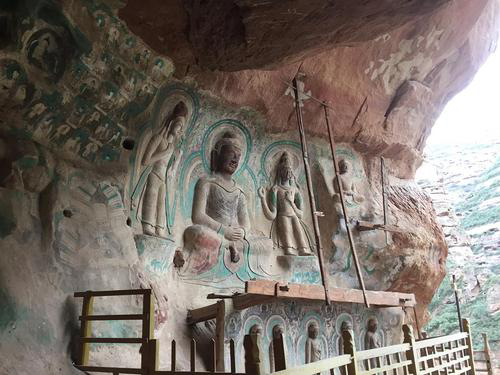
Bingling Temple or Jampa Bumling is a series of grottoes filled with Buddhist sculpture carved into natural caves and caverns in a canyon along the Yellow River. It lies just north of where the Yellow River empties into the Liujiaxia Reservoir. The site is in Yongjing County of Linxia Hui Autonomous Prefecture in Gansu province, it is about 100 km southeast of Lanzhou. Bingling is the transliterating of the Tibetan “thousands of Buddhas”. Originally built in 420 in Western Qin Dynasty (385-400), the Bingling Temple Caves was continuously dug in later dynasties, and some painted decorations even done in Yuan Dynasty (1271-1368) and Ming Dynasty (1368-1644). There are existing 183 caves, 694 stone statues, 82 clay statues and about 900 square meters frescos, stretching 200 meters along west bank of Temple Channel on a 60-meter-high cliff. With the giant Buddha of No.169 Cave being the main part, the 183 caves are scattered in upper temple, lower temple, temple channel as well as the Buddha terrace. The stone sculptures in Bingling caves are representing the social situations and customs during ancient times. In the vicinity of the caves are green hills, crystal-clear water, grotesque stones and precipitous cliffs, which add more beauty to this artistic site. After the founding of People’s Republic of China, the State Council designated the site as a key cultural relic, and placed it under state protection.
 Tibet World Travel Tibet Tour, Tibet Trip, Tibet Travel, Tibet Train, Tibet Trekking,
Tibet World Travel Tibet Tour, Tibet Trip, Tibet Travel, Tibet Train, Tibet Trekking,
